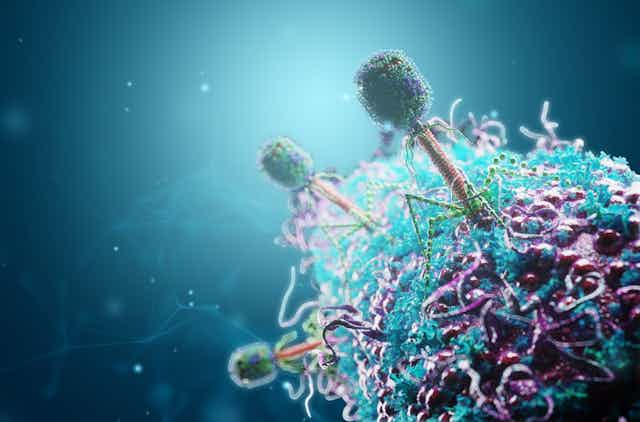We often hear about the importance of the human microbiome – the vast collection of bacteria and fungi that live on and inside us – when it comes to our health. But there’s another, equally important part of this microbial community that remains far less known: the virome.
The virome consists of all the viruses that inhabit our bodies. This includes those that infect humans cells, bacteriophages (viruses that infect bacteria) and the viruses we aquire from our diet and environment.
Viruses are the most abundant biological entities on Earth, with an estimated 10³¹ viral particles globally and about 10¹³ in each human being.
For centuries, viruses have been seen mainly as causes of disease. But research suggests that viruses influence our health in important ways.
Bacteriophages, for instance, play a crucial role in regulating the bacterial populations in our gut. By keeping harmful bacteria in check, they help prevent conditions such as inflammatory bowel disease (IBD) and obesity.
Certain bacteriophages can also enhance the immune system’s ability to combat bacterial infections. They do this by breaking down the outer membranes of harmful bacteria – releasing antigens that stimulate immune responses.
Some viruses that interact directly with our immune system even help maintain its balance – potentially protecting us from illnesses. For instance, herpesvirus, which causes cold sores and mononucleosis (mono), can alter immune responses. It does this in many ways – such as by promoting the production of specialised immune cells, altering the gene expression of cells and even suppressing anti-inflammatory responses. These changes may potentially reduce risk of developing secondary infections and allergic responses later in life.
Conversely, some viruses might contribute to chronic inflammation by persistently activating immune pathways.
The balance of these interactions is critical. A healthy virome helps fend off infections and support overall health. But an imbalanced virome may contribute to poor health and disease.
Recent discoveries
The field of virome research has advanced rapidly thanks to innovations in DNA sequencing. Techniques like shotgun sequencing allow scientists to analyse entire viral communities. This has revealed a wealth of previously unknown viruses and deepening our understanding of their roles in health and disease.
Improved methods for isolating viral particles have also made it possible to analyse samples. Bioinformatics tools and databases, such as ViromeQC and the Gut Virome Database, may further support the identification and classification of viral sequences – making it easier to explore these complex communities.
These innovations also mean researchers better understand the complexity of the virome and its role in human health.
For example, research published earlier this year which tracked infants and their mothers found significant differences in their viromes. This indicates that an infant’s virome is shaped by factors such as diet and environment, rather than being inherited from the mother.

Another study showed that newborns typically have no detectable virome at birth, but quickly acquire a diverse array of viruses, mainly bacteriophages, shortly after birth. These viruses are probably picked up from their environment, diet and the people they’re in close contact with.
Alterations in the virome have been linked to various diseases, as well. For instance, changes in gut viral populations have been associated with inflammatory bowel disease, type 2 diabetes and hypertension. Patients with IBD often have higher levels of certain bacteriophages, suggesting these viruses may play a role in the disease’s development.
Understanding the virome could revolutionise medicine and public health. One exciting possibility is phage therapy, where bacteriophages are used to target and destroy harmful bacteria. This approach could offer a powerful tool against antibiotic-resistant infections.
Read more: Antibiotic resistance: scientists are reengineering viruses to cure bacterial infections
Identifying specific virome changes could also lead to new diagnostic markers for diseases – possibly enabling earlier and more accurate interventions.
The virome’s interaction with the immune system could hold promise for new vaccines and immune therapies, as well. By studying how certain viruses modulate immune responses, scientists could develop vaccines that better protect against infections.
Personalised medicine could also benefit from virome research. Since each person’s virome is unique, treatments tailored to a person’s unique viral composition could enhance the effectiveness of therapies for a range of conditions, from gastrointestinal disorders to autoimmune diseases.
The virome represents an exciting new frontier in our understanding of human health. As research continues to unveil the intricate interactions between viruses and their hosts, we can expect significant advances in the diagnosis, treatment and prevention of diseases.

